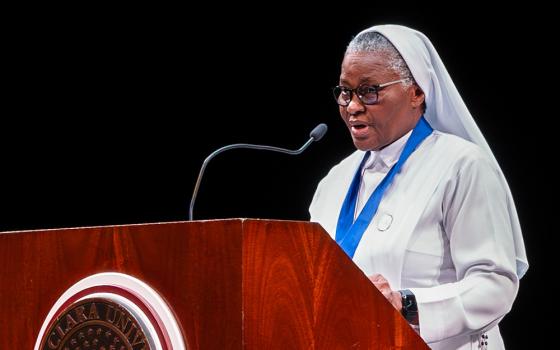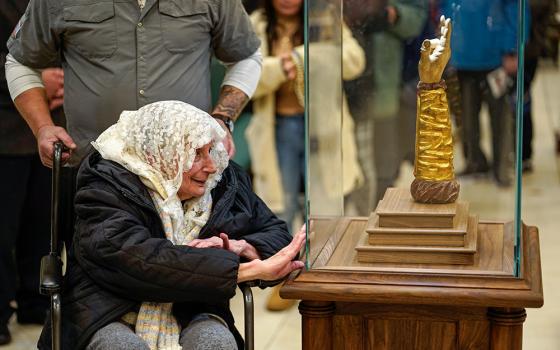
The Holy Father needs to directly answer questions, in a credible forum, about his role -- as archbishop of Munich (1977-82), as prefect of the Congregation for the Doctrine of the Faith (1982-2005), and as pope (2005-present) -- in the mismanagement of the clergy sex abuse crisis.
We urge this not primarily as journalists seeking a story, but as Catholics who appreciate that extraordinary circumstances require an extraordinary response. Nothing less than a full, personal and public accounting will begin to address the crisis that is engulfing the worldwide church. It is that serious.
To date, as revelations about administrative actions resulting in the shifting of clergy abusers from parish to parish emerge throughout Europe, Pope Benedict XVI's personal response has been limited to a letter to the Irish church. Such epistles are customary and necessary, but insufficient.
With the further revelations March 26 by The New York Times that memos and meeting minutes exist showing that Benedict had to be at least minimally informed that an abuser priest was coming into the archdiocese of Munich and that he further had been assigned without restrictions to pastoral duties, it becomes even more difficult to reconcile the strong language of the pope in his letter to Irish bishops and his own conduct while head of a major see.
No longer can the Vatican simply issue papal messages -- subject to nearly infinite interpretations and highly nuanced constructions -- that are passively "received" by the faithful. No longer can secondary Vatican officials, those who serve the pope, issue statements and expect them to be accepted at face value.
We were originally told by Vatican officials, for example, that in the matter of Fr. Peter Hullermann, Munich Archbishop Joseph Ratzinger approved the priest's transfer to the archdiocese, but had no role in the priest's return to parish ministry, where he again molested children. Rather, it was Fr. Gerhard Gruber, archdiocesan vicar general at the time, who, according to a March 12 Vatican statement, has taken "full responsibility" for restoring the priest to ministry. Gruber, subsequent to his statement, has not made himself available for questions.
We are told, moreover, that the case of Hullermann is the single instance during Ratzinger's tenure in Munich where a sexually errant priest was relocated to a parish where he could molest again. If true, this would be a great exception to what, in the two-and-a-half decades NCR has covered clergy abuse in the church, has been an ironclad rule: Where there is one instance of hierarchical administrative malfeasance, there are more.
Given memos and minutes placing the pope amid the discussions of the matter, we are asked to suspend disbelief even further.
Context of mismanagement
The first reported clergy sex abuse stories, dating back in NCR to 1985, focused on the misconduct of priests who had been taken to court by parents of molested children -- parents who had gone to church officials, but received no solace. Instead, what they received from church officials was denial and counter accusation.
Almost from the beginning of the coverage of these trials, it was clear the clergy sex abuse story had two consistent components: the abusing priest and the cover-up by the bishop.
The story grew as more survivors of abuse came forward. What soon became evident was that this was not primarily a story of wayward priests, but of an uncannily consistent pattern by individual bishops. In nearly every instance, bishops, faced with accusations of child abuse, denied them, even as they shuffled priests to new parishes, even as they covered up their own actions.
The story was first flushed out in the United States and soon across Canada. By the year 2000, sex abuse accusations were turning up across the globe. In the United States, the scandal flared anew in 2002 when a judge released thousands of pages of documents dealing with the sex abuse scandal in the Boston archdiocese. Suddenly, ordinary Catholics had access to the patterns involved in the cover-up and to the unfiltered language of memos and legal depositions and letters that outlined how church officials sought to protect perpetrators and marginalize their victims. All at once, the public outrage was commensurate with the hierarchy's outrageous behavior. The story would repeat itself around the country: Wherever documents were released or legal authorities conducted investigations, the depth of clerical depravity and the extent of hierarchical cover-up were far greater than previously acknowledged by church authorities.
Knowing they had an unprecedented crisis of credibility and facing potential multibillion-dollar liability, the U.S. bishops met in Dallas in June 2002. The whole world, represented by more than 800 members of the press, was watching.
There the prelates unveiled what came to be a "Charter for the Protection of Children and Young People." It was intended to protect children from molestation, establishing a "one strike and you're out" policy for offending priests. It did nothing, however, to hold accountable individual bishops who engineered the cover-up.
By early 2001, responsibility for managing the church's response to the ongoing crisis was delegated to the Congregation for the Doctrine of the Faith, headed by Cardinal Ratzinger. The Vatican, by then, viewed the crisis as beyond the boundaries of any one national church.
Crisis crosses borders
In the last decade the story has not gone away. Rather it has continuously reared its head in nation after nation, especially in those countries with a free press and independent judicial system. A dominant characteristic of this story is that where and when it has emerged it has done so without the aid of church hierarchy. To the contrary, it has taken lawsuit after lawsuit, investigative report after investigative report, to bring this horrendous story to necessary light.
Another part of the pattern of this dispiriting tale is that church officials have never been in front of the story. Always late, always responding, and, therefore, at every step of the way losing credibility. This seemed to be the case once again with Benedict's pastoral letter to Irish Catholics.
By the time he issued the letter, the story had moved to his native country, Germany, and had touched him personally. In the past two months, there have been more than 250 accusations of sex abuse in Germany. From the German Catholic viewpoint, the pope's failure to mention anything about these abuse cases has pained them deeply and added to suspicions that the former archbishop of Munich has lost touch with his people.
Inexorably, a story that began with reports on trials in a few U.S. cities a quarter century back has now moved up the Catholic institutional ladder -- from priests to bishops to national bishops' conferences and to the Vatican itself. This last step is the one we see emerging this month. The new focus is unlikely to end anytime soon.
Time for answers
The focus now is on Benedict. What did he know? When did he know it? How did he act once he knew?
The questions arise not only about his conduct in Munich, but also, based also as prefect of the Congregation for the Doctrine of the Faith. A March 25 Times story, citing information from bishops in the United States, reported that the Vatican had failed to take action against a priest accused of molesting as many as 200 deaf children while working at a school from 1950 to 1974. Correspondence reportedly obtained by the paper showed requests for the defrocking of the priest, Fr. Lawrence Murphy, going directly from U.S. bishops to Ratzinger, then head of the Congregation for the Doctrine of Faith, and Cardinal Tarcisio Bertone, now the Vatican secretary of state. No action was taken against Murphy.
Like it or not, this new focus on the pope and his actions as an archbishop and Vatican official fits the distressing logic of this scandal. For those who have followed this tragedy over the years, the whole episode seems familiar: accusation, revelation, denial and obfuscation, with no bishop held accountable for actions taken on their watch. Yes, there is a depressing madness to this story. Time after time, this is a story of institutional failure of the deepest kind, a failure to defend the Gospel of Jesus Christ, a failure to put compassion ahead of institutional decisions aimed at short-term benefits and avoiding public scandal.
The strategies employed so far -- taking the legal path, obscuring the truth, and doing everything possible to protect perpetrators as well as the church's reputation and treasury -- have failed miserably.
We now face the largest institutional crisis in centuries, possibly in church history. How this crisis is handled by Benedict, what he says and does, how he responds and what remedies he seeks, will likely determine the future health of our church for decades, if not centuries, to come.
It is time, past time really, for direct answers to difficult questions. It is time to tell the truth.



